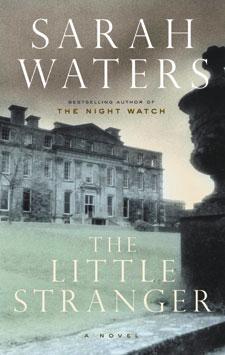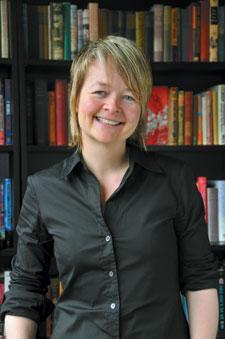
Credit: Nicola Betts
Sarah Waters has a lot to answer for. In 2002 the BBC adaptation of her first novel, a sexy lesbian romp called Tipping the Velvet, got mainstream Britain talking about strap-on dildos. The media sensed a cultural “moment” and suddenly newspaper columnists were noting that lesbianism was, well, cool. Since then Waters has become something of a lesbian literary powerhouse. She was one of 10 people chosen by the National Portrait Gallery to work on their first-ever Gay Icons exhibition currently running in London. Her last two novels were bestsellers, all four have been adapted for television and she’s won numerous literary awards.
Despite mainstream success Waters has always been vocal about her own sexuality and lesbian characters appear in all her novels. It’s the past that inspires her, partly because she wants to challenge the idea that homosexuality is a modern invention. “It’s interesting to go back,” she says, “to revisit our stereotypes and our fictions of the past and deliberately put gay characters in them to see how that changes the landscape.” Traditionally historical fiction has mirrored the dominant narratives of our culture; over the last decade Waters has been doing a good job of queering it up.
Which is why her new novel, The Little Stranger, long-listed for a Booker, is a bit of a departure. It’s a gothic ghost story, full of suspense-filled moments and chilling revelations, but there are no lesbians in it. “It wasn’t at all calculated,” she says with a laugh. “I could tell early on that the story that was interesting me wasn’t a lesbian one. Which did seem odd at first and I did think, ‘Oh my God, I’ve got this reputation as a lesbian writer!’ But then pretty rapidly it was just the book it was and that’s all there was to it.”
The Little Stranger is set in the 1940s, a decade Waters first explored in her last novel, The Night Watch. It was a wrench to leave the Victorian age — the setting of her first three novels — but once she started researching the ’40s she fell in love with them. “There’s something fascinating about the post-war period,” she says. “People have just been through this extraordinary experience and are readjusting, not knowing where things are going next. That really appealed to me.”
At the heart of the story is Hundreds Hall, a towering country mansion that has fallen into disrepair. The house is so intricately drawn, it’s almost a character in itself; its crumbling façade a metaphor for the fragile emotional state of the family within. It becomes a “frightful burden” that “needs to be fed all the time, with money and hard work.” Behind its doors the Ayreses struggle to maintain the appearance of an upper-class lifestyle. But their old life is gone and, like their once-grand ancestral home, the family is gradually falling apart.
It’s a fascinating picture of a unique period in history, when the aftermath of war turned the British class system on its head. But it’s also a stunning work of gothic fiction, a type of horror writing that embraces the transgressive elements of human nature. Waters herself is a big fan of the genre; her third novel, Fingersmith, is a masterful piece of Victorian gothic. In fact the gothic has long attracted writers with an interest in queer identities, perhaps because its common themes — madness, repressed desire and the supernatural, to name a few — are beyond the boundaries of normative culture. This opens up a space to explore alternative ideas about gender and sexuality.
Waters challenges gender norms in her depiction of Caroline Ayres, who has a whiff of butch about her. The Doctor tells us that he’s “regularly heard her referred to locally as ‘rather hearty,’ a ‘natural spinster,’ a ‘clever girl’ — in other words she was noticeably plain, over-tall for a woman, with thickish legs and ankles.” She refuses to dress like other women of her class, often wearing “boyish flat sandals” and ill-fitting dresses. She’s not a lesbian, but she does represent a powerful challenge to the gender roles of the time. Waters also sees a queer element to the Doctor’s courting of Caroline. “I was writing as a man desiring a woman,” she says, “and of course that’s heterosexual, but because of my reputation as a lesbian writer, it might have a slightly queer edge for people.”
Queer readings aside, is Waters worried the lack of lezzie action will disappoint her fans? “I totally understand why people might feel I’m diverting my energies away from lesbianism,” she says. “It’s not like we’ve got tons of people writing our stories and getting them into the mainstream. But it’s not that I’m never going to write about lesbians ever again and it’s not like I’ve gone back in the closet! There are lots of things about my writing that I hope lesbians enjoy, not just the lesbian elements.”
Which raises the question: What makes a novel “lesbian” — the content or the author? Perhaps a bit of both, or perhaps the tag is becoming less relevant. Waters is on the fence. “I think labels can be helpful, but they can be unhelpful too because they pen you in a bit,” she says. “You can’t control how you’re read and categorized so I’ve never really tried to. My main energies go into writing the books and as for the other side of it, I’m interested to see where it goes.”
Wherever it does go, a new novel from Waters will always be a queer event. Because whether she’s writing about doctors or thieves, ambulance drivers or spinsters, her characters challenge the conventions that surround them. And that’s always something to celebrate.
****
The Little Stranger: Excerpt
A doctor sees lots of tears; some more affecting than others. I really did have a heap of chores at home, and was not at all amused to have been dragged away from them for nothing. But she looked so young and pathetic, I let her have the cry out. Then I touched her shoulder and said firmly, “Come on now, that’s enough. Tell me what the trouble is. Don’t you like it here?”
She produced a limp blue hand-kerchief from under her pillow, and blew her nose.
“No,” she said, “I don’t.”
“Why not? Is the work too hard?”
She gave a hopeless shrug. “The work’s all right.”
“You don’t do it all by yourself though, surely?”
She shook her head. “There’s Mrs Bazeley comes in, every day till three; every day bar Sunday. She does the washing and the cooking, and I does everything else. A man has a go at the gardens, sometimes. Miss Caroline does a bit . . .”
“That doesn’t sound too bad.”
She didn’t answer. So I pressed on. Did she miss her parents?
She pulled a face at that idea. Did she miss a boyfriend? She pulled a worse face at that.
I picked up my bag. “Well, I can’t help you if you won’t say.”
And seeing me start to rise, she said at last, “It’s just, this house!”
“This house? Well, what about it?”
“Oh, Doctor, it in’t like a proper house at all! It’s too big! You have to walk a mile to get anywhere; and it’s so quiet, it gives you the creeps. It’s all right in the daytimes, when I’m working, and Mrs Bazeley’s here. But at night, I’m all on me own. There in’t a sound! I have horrible dreams….”

 Why you can trust Xtra
Why you can trust Xtra


